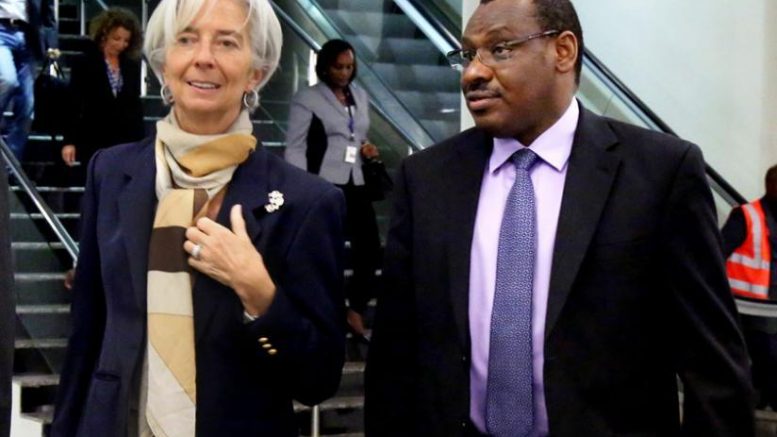January 11th; 2017
The following is from IMF Communications Department:
January 6, 2017
- Program implementation has been strong, with almost all targets met. Early evidence suggests that short term adjustment policies are starting to check external imbalances.
- As expected, growth has slowed modestly, but remains robust, with projections around 6.0 percent in 2016-2017. Inflation has risen modestly, due to food prices.
- The agreed policy mix remains appropriate for safeguarding external and fiscal sustainability, while supporting growth. Further monetary tightening may be needed, should more broad-based inflation pressures emerge.
The Executive Board of the International Monetary Fund (IMF) today completed the sixth review of Rwanda’s performance under the Policy Support Instrument (PSI) [1] and the first review of the arrangement under the Standby Credit Facility (SCF) [2] . The Board’s decision was taken on a lapse of time basis. [3]
Requests for an 18-month SCF arrangement with access of about US$204 million (SDR 144.18 million) or 90 percent of Rwanda’s quota and to extend Rwanda’s PSI-supported program through end-2017 (see Press Release No. 16/270 ), were approved by the Board on June 8, 2016. Half was disbursed upon approval of the SCF arrangement, and with completion of the first review of the SCF arrangement another US$48.65 million (SDR 36.045 million) becomes available for disbursement. The remaining financing will be considered in two subsequent reviews in 2017. Rwanda’s PSI-supported program was originally approved on December 2, 2013 (see Press Release No.13/483 ). In completing the reviews, the Board also approved modification of end-December 2016 program targets (to reflect new information on external assistance) and granted a waiver for a minor and temporary non-observance of the continuous zero limit on external arrears accumulation.
The main near-term objective of the current programs is to respond to adverse global developments, most notably commodity prices, which has led to growing external imbalances, resulting in pressure on the Rwandan franc and the banking system’s foreign exchange reserves. Restoring external sustainability is imperative for realization of medium-term program objectives, namely sustained high and inclusive growth, including through public infrastructure investment, and reduced dependence on donor support through higher domestic revenues.
Early evidence suggests that the short term adjustment policies have been effective in addressing external imbalances. The authorities have continued to allow exchange rate flexibility to serve as the main policy adjustment instrument, with depreciation of 9 percent over the first 10 months of 2016, complemented by modest fiscal consolidation and monetary tightening. These demand management policies have been accompanied by the government’s home-grown “Made in Rwanda” initiative, which seeks to substitute domestic production for some key imported goods, and export promotion efforts. Performance under the program has been strong, with almost all program targets set through end-June 2016 and structural reforms through end-September 2016 being achieved.
The agreed policy mix remains appropriate for safeguarding external and fiscal sustainability, while supporting growth objectives. If current trends continue, the current account deficit should fall over the course of 2017-18, bringing official reserves above 4 months of imports. The authorities have acted decisively to address growing external imbalances and thereby should avoid more painful adjustment that otherwise would have been needed, as illustrated by the experience of some other countries adversely affected by commodity prices.
Inflation pressure is currently supply driven with end-year inflation projections of 6.0 percent and 5 percent over the medium term. But the situation should be monitored closely to assess potential second-round effects of the inflationary impact of a depreciated exchange rate, and more monetary tightening may be needed if inflation pressures are greater than projected. Clearer communication regarding the policy stance could help steer inflation expectations. Decisive efforts would be needed to develop minimum conditions for inflation targeting within the agreed East African Community timeline.
Looking ahead, risks to the growth outlook are balanced. The government’s deliberate incentives to promote domestic production and add value to its exports should keep growth buoyant. However, should the drought be prolonged, both growth and inflation could be adversely affected.
[1] The PSI is an instrument of the IMF designed for countries that do not need balance of payments financial support. The PSI helps countries design effective economic programs that, once approved by the IMF’s Executive Board, signal to donors, multilateral development banks, and markets the Fund’s endorsement of a member’s policies (see http://www.imf.org/external/np/exr/facts/psi.htm ). Details on Rwanda’s current PSI are available at www.imf.org/rwanda.
[2] The SCF provides financing to low-income countries on concessional terms. For more details, see http://www.imf.org/external/np/exr/facts/scf.htm .
[3] The Executive Board takes decisions without a meeting when it is agreed by the Board that a proposal can be considered without convening formal discussions.
Source:
http://www.imf.org/en/News/Articles/2017/01/06/PR1702-Rwanda-IMF-Executive-Board-Completes-Sixth-PSI-Review-First-Review-Under-SCF

